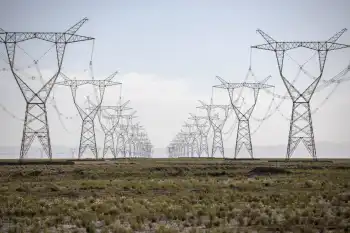Pilot project uses smart meters to control costs
SOUTH BEND, INDIANA - GE Energy and American Electric PowerÂ’s (AEP) Indiana Michigan Power subsidiary announced the deployment of 10,000 GE Energy smart meters in a pilot project in South Bend, Ind., that will begin January 1, 2009.
The pilot program will help consumers track their electricity consumption and empower them to control their energy costs. AEP also will deploy a variety of GE Energy smart grid products and technology solutions that will help it improve productivity and power reliability, increase energy efficiency, more quickly restore power after an outage and reduce the need for new power plants.
“Smart grid solutions enable utilities to increase energy productivity and power reliability while empowering consumers to better manage their electricity consumption and costs through real-time knowledge exchange,” said Bob Gilligan, vice president of GE Energy’s transmission and distribution business. “This will help electricity customers and consumers lower their carbon footprints, without having to compromise lifestyle or habits.”
Many consumers are not aware that the cost to produce electricity varies throughout the day based on demand. Electricity is typically cheaper to produce in the evening during times of low demand (off-peak) and more expensive during the day when demand is higher (peak).
For most residential electricity customers, electricity pricing doesn't vary; instead, consumers typically pay one set price regardless of the time of day. Smart meter technologies can change this, with a feature called "time of use" pricing, which offers lower prices during off-peak periods and higher during peak periods, making the purchase of electricity like the purchase of most other consumer goods — with price impacting purchase decisions.
With the optional benefit of “direct load control,” smart meters will also enable automatic adjustment for high energy consuming devices, such as central air conditioning units, during periods of peak demand and higher electricity prices. This capability puts consumers in control of their choices around comfort and cost.
Additionally, these meters also will allow consumers to pre-pay for electricity, giving another dimension of control for those who choose the convenience of pre-payment or for those who prefer more structure in personal budgeting.
There is no greater hassle for electricity customers than power outages. The suite of smart grid products and technologies implemented by AEP will help maximize system uptime (or power reliability), while also helping the utility more quickly restore power to homes and businesses in the event of an outage.
In addition to monetary and convenience benefits, consumers will be part of the effort to employ smarter energy alternatives designed to help reduce the growing energy demand, thereby helping customers conserve energy and reduce their carbon emissions.
According to a one-year study by the U.S. Department of Energy, smart meters achieved 10 percent overall electricity conservation and a 15 percent reduction in peak time electricity use.
The efficiency gains achieved by upgrading to a smarter grid from a conventional grid would be like switching from a typewriter to a word-processor. The smart grid is not a “product,” but rather a strategic collection of smart devices and applications applied to the grid that provide an abundance of real time information on the performance of the grid and allow for smarter and faster decisions to be made. These products include hardware, like smart meters and capacitors, and software, like geospatial information systems and demand-side management.
As part of the pilot program, GE Energy will also provide home area networking equipment, enabled by the GE Energy smart meter. GE Energy will integrate a GE Outage Management System (PowerOn), along with a GE Distribution Management System (ENMAC), which will allow for distribution automation functionality, all integrated through the wireless infrastructure being installed.
Related News

Opinion: Would we use Site C's electricity?
VANCOUVER - There are valid reasons not to build the Site C dam. There are also valid reasons to build it. One of the latter is the rapid increase in clean electricity needed to reduce B.C.’s greenhouse gas emissions from burning natural gas, gasoline, diesel and other harmful fossil fuel products.
Although former Premier Christy Clark casually avoided near-term emissions targets, Prime Minister Justin Trudeau has set Canadian targets for both 2030 and 2050. Studies by my research group at Simon Fraser University and other independent analysts show that B.C.’s cost-effective contribution to these national targets requires us to reduce our…




